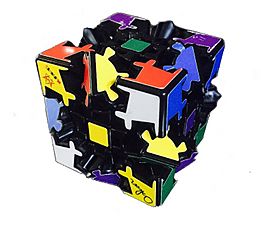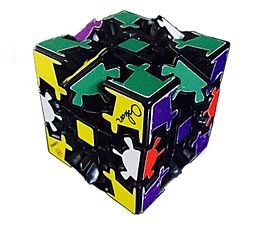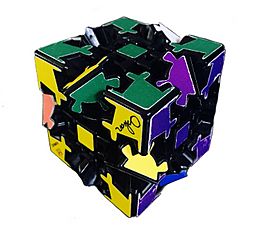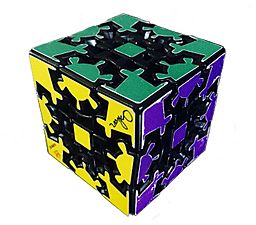Gear Cube facts for kids
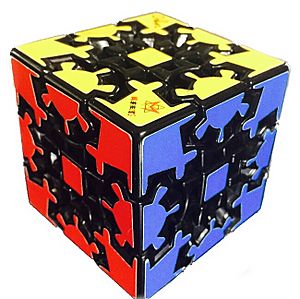 |
|
| Other names | Caution Cube |
|---|---|
| Type | Combination puzzle |
| Inventor(s) | Oskar van Deventer |
| Company | Meffert's |
| Country | Netherlands |
The Gear Cube is a cool 3-D puzzle. It was created by a Dutch puzzle maker named Oskar van Deventer. He got the idea from Bram Cohen.
When it first came out in 2009, it was called the "Caution Cube". This was because players could sometimes get their fingers stuck in the gears! Later, in 2010, a company called Meffert's started making lots of them. That's when it became known as the "Gear Cube".
Unlike a regular Rubik's Cube, the Gear Cube uses a full gear system. This means it moves differently. You need six half-turns (180° turns) to make one full rotation. Even though it looks tricky, many people find it easier to solve than a classic Rubik's Cube.
When you solve the Gear Cube, you have two main goals. First, you want to get the mixed-up puzzle back into its perfect cube shape. Second, you need to arrange each side so all the colors match up again.
Contents
How the Gear Cube Works
The Gear Cube is mostly made of gears! It has a lot of possible ways its pieces can be mixed up, about 41,472 different permutations.
Each side of the cube can only turn 180 degrees, which is a half-turn. This is because of how the gears are connected. They don't let you make smaller 90-degree turns. So, all the moves you make will be half-turns or full rotations.
The cube has six center pieces, one for each color. These center pieces always stay in place and opposite each other. They decide what color each side of the cube will be. These centers are just like those on a classic Rubik's Cube. They are held together by a special cross shape inside, with screws that let you adjust how tight the cube feels.
How to Solve the Gear Cube
Understanding Cube Moves
Many puzzle solvers use a special language to describe how to move a cube. This is called "Singmaster notation." It was created by David Singmaster. This notation helps you follow instructions no matter which way you are holding the cube.
- F (Front): This is the side of the cube facing you.
- B (Back): This is the side opposite the front.
- U (Up): This is the side on top of the front side.
- D (Down): This is the side underneath the cube.
- L (Left): This is the side to the left of the front.
- R (Right): This is the side to the right of the front.
If you see a little mark ( ' ) after a letter, like R', it means you should turn that side counter-clockwise. If there's no mark, like R, you turn that side clockwise.
For example:
- R means turn the right side clockwise.
- R' means turn the right side counter-clockwise.
Sometimes, a number follows a letter, like F2. This just tells you how many times to turn that side.
For example: F2 means turn the front side two times clockwise.
You might also see moves in parentheses, like (R' F B L') 2. This means you do the moves inside the parentheses, then repeat that whole set of moves again.
Key Solving Steps
To solve the Gear Cube, you only need to learn two main sets of moves, called algorithms:
- To swap an upper-front edge gear with the upper-back edge gear: (R2 U) 2
- To get all edge gears into a perfect cubic shape: R4 (Repeat this as many times as needed).
Solving the Cube Step-by-Step
Solving the Gear Cube is mostly about looking closely at the puzzle and figuring out what needs to happen. You only need two main sets of moves, so spotting the patterns is very important! Once you see the patterns, using the moves is easy.
Phase 1: Fix the Corners (This step is about using your own logic; there are no special moves needed here.)
Step 1: Find two corner pieces that belong together and get them next to each other. For example, find two green corners that also have matching side colors. Move the cube around until they are paired up.
Step 2: Once you pair two green corners, the other two green corners should also be paired. They might be on a different part of the cube.
- Pair both sets of green corners to complete the green side.
- Then, turn the opposite (blue) side until all its corners match up too.
- Finally, turn each side until its corners match the color of its center piece.
Phase 2: Place the Edge Pieces (Now you'll use your first set of special moves!)
Step 1: Look for two gear edge pieces that are across from each other and need to be swapped. They should be in the wrong spot, not matching the colors of the two sides they are between.
- Hold the cube so these two edges are on the top side (one at the upper-front and one at the upper-back).
- Then, do this set of moves: (R2 U) 2.
Step 2: Keep repeating the step above until all the edge pieces are in their correct spots. This means their colors should match the colors of the sides they are between.
Phase 3: Straighten the Edges (Time for your second set of special moves!)
Step 1: Turn all the sides until the cube is back in a perfect cubic shape. Use this set of moves: R4 (repeat this as many times as needed until the cube is a perfect cube).
Different Kinds of Gear Cubes
There are many different versions of the Gear Cube. Some are simpler, like the 2x2 Gear Shift, and some are much harder, like the 3x3 Even Less Gears Cube. Three 3x3 cubes are very similar to the original: the Gear Cube Extreme, the Gear Cube Ultimate, and the Even Less Gears Cube.
Gear Cube Extreme: This cube is also called the Anisotropic Cube. The original Gear Cube has 12 gears, but the Gear Cube Extreme only has eight. The gears are only on the top and bottom rows. The middle row has regular edges instead of gears. This change allows the cube to make 90-degree turns on two rows, and 180-degree turns on four rows.
Gear Cube Ultimate: This cube is built just like the Gear Cube Extreme, with eight gears. The only difference is that it has extra stickers on the four inner pieces of each side. These stickers make it a bit harder to solve because you have to make sure they are also correctly lined up. Sometimes, you might solve the whole cube, but these new stickers are still mismatched!
Even Less Gears: This is a 3x3 Gear Cube with only four gears! It removes even more gears and replaces them with standard edges. As the number of gears goes down, the puzzle usually gets harder. With this cube, four sides can make 90-degree turns, but the other two sides still use gears and can only make 180-degree turns.
Gear Ball: This puzzle is shaped like a ball and has two sets of edges. The outer edges are gear-shaped with six teeth. The inner edges are smaller and have only two teeth. The corners also have a special three-pronged barrier. This cube is made by Meffert's, the same company that invented the Pyraminx.
Other Gear Puzzles
- Gear Shift
- Skewb Shift
- Gear Egg
- Gear Cube Extreme
- Gear Cube Ultimate
- Even Less Gears Cube
- Gear Barrel
- Gear MasterMorphix
- Gear Pyraminx
- Gear Minx
See also
 In Spanish: Gear Cube para niños
In Spanish: Gear Cube para niños


